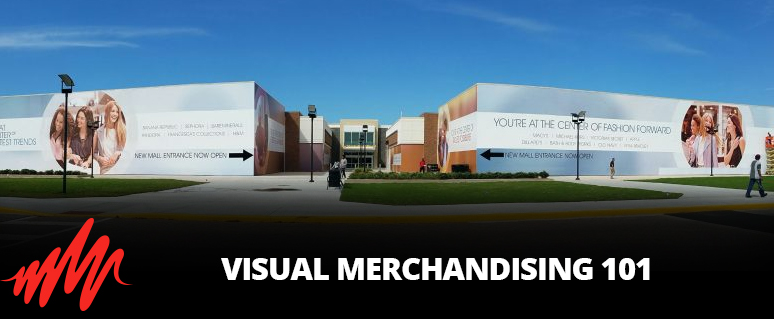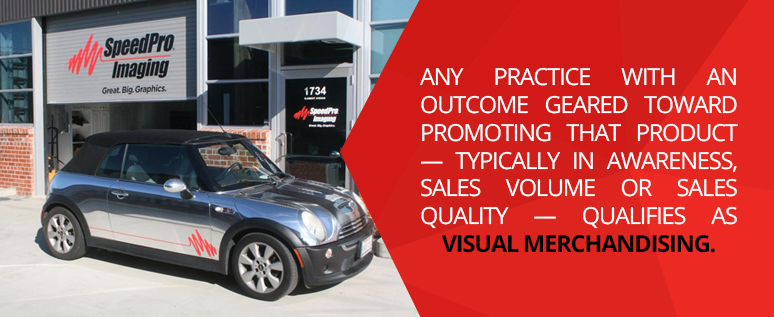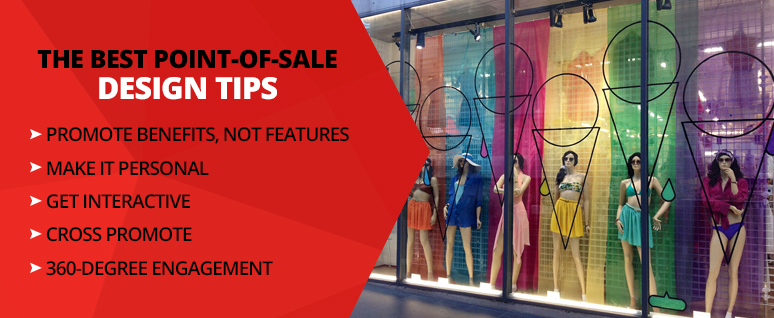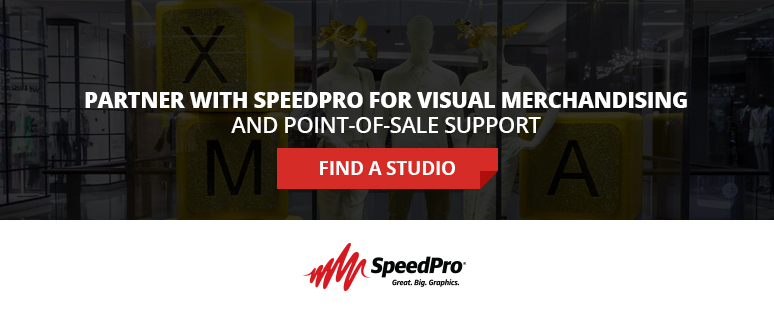
Visual Merchandising 101
MARCH 4, 2019| SpeedProCategories
RetailYou’ve heard of them. You’ve seen them. You’ve interacted with them — in stores, at conferences, around trade show floors and convention booths, maybe during a community-wide event. You’ve probably even bought something from them.
They’re point-of-sale (POS) and point-of-purchase (POP) displays, and they remain the bedrock of today’s successful visual merchandising strategies.
Businesses master visual merchandising to put their best selves forward. In and out of retail environments, these displays are built to maximize in-the-moment marketing — and help you become a branding and sales aficionado.
Today we’re covering the basics of visual merchandising — its terms, techniques, types, usage tips and much more — so your display stands can take center stage at your next industry conference.
What Is Visual Merchandising?
Visual merchandising refers to the variety and display of products for sale. Any practice with an outcome geared toward promoting that product — typically in awareness, sales volume or sales quality — qualifies as visual merchandising.
Retailers use visual merchandising to highlight specific goods, such as displays for their latest winter apparel line or a new set of baking equipment. Corporate offices use visual merchandising during product launches or to stand out at conferences and trade shows. Manufacturers use visual merchandising at expos, conventions and other industry events. In other words, if you’re in the business of selling something, you’re in the business of visual merchandising.
There are two main types of visual merchandising:
- In-store merchandising: Displays stationed within actual store environments qualify as in-store merchandising. Just as the name suggests, this visual merchandising technique requires a physical storefront to function. Product displays are often near registers or stationed within the aisles, departments, walls or floors of the products they’re promoting. In both cases, the display stands are quite literally trying to coax a sale, often as a customer’s in-store, add-on item.
- Out-of-store: Displays that still highlight a particular good or product but do so outside of a store fall into the aptly named out-of-store visual merchandising category. Think conventions, product expos, industry conferences, corporate events, trade shows and the like, where companies aim to nurture product and brand awareness, forge internal and external vendor connections and increase the distribution or sales of its goods. Online visual merchandising is sometimes considered out-of-store as well, though products advertised online hold their own attention and awareness strategies that don’t quite align with many in-person visual merchandising tactics included here.
What Are Visual Merchandising Techniques in Retail?
Point-of-purchase or point-of-sale stands are marketing installations placed with or near the actual merchandise they’re promoting.
Both terms are used interchangeably, each referencing the same designed installation with the same overall outcome — increase buyer awareness and boost sales of a particular good.
POP and POS displays work to draw consumer attention to the product advertised. Applying a range of design strategies, skills and insights, POP displays become a powerful visual marketing tool with purchase-persuading muscle. Creating them requires finesse, however — an eye toward capturing the attention of busy, in-person shoppers or conference attendees. That attention then needs to be rewarded. Visual merchandising techniques need to pull through to inform, engage and excite passive booth visitors to turn them into actual purchasers.
When it comes to compelling visual merchandising point-of-sale techniques, a few reign supreme:
- Physical POP stands: Physical POP displays are set up at industry or community events, retail stores and corporate businesses. Vendors place POP stands next to their merchandise, or may even find ways to incorporate the merchandise itself into the display, showcasing items in a manner far more captivating than shelving. Physical POP stands are also an essential branch of branded company graphics, which makes them key items to include at conferences or expo setups, kiosks and booths where brand imagery and impact matter.
- Digital POP displays: Digital POP displays use screens to highlight a particular good or line of goods. They’re a modern take on physical POPs. Digital POP stands will often be made from the same banners, wall panels, and other printed materials typical to the POS display, yet showcase products with screens or other digital features.
- Interactive POP displays: This visual merchandising category can incorporate both physical and digital POP stand characteristics, but with a twist that allows visitors to interact with the stand in some manner. From touch screen product catalogs to taking and submitting selfies, interactive POP displays are particularly useful at public events like trade shows.
- Combination displays: Digital screens can be worked within the walls, panels and attachable shelving of physical POP stands. Interactive activities or actions can be encouraged with digital POS displays. All three techniques — physical, digital and interactive — can come together to build a stand-out booth at your next conference.
How to Use Point-of-Purchase Displays in Visual Merchandising
Many product manufacturers will create POP or POS displays to hand out to vendors and retailers freely. Vendors can then set up individual stands wherever they see fit in their storefronts, with many leveraging POP and POS displays into cross-promotion opportunities. Together, these efforts become a cohesive, real-time visual merchandising campaign effective right as consumers shop.
However, storefronts are far from the only appropriate place for POS visual merchandising. Both POS and POP displays are made for professional and industry events. Vendors require eye-catching graphics to outfit their booths and kiosks. Plus, those graphics have to deliver, providing brand-boosting information and experiences to all who stop by.
Where can you use POS and POP stands for enhanced visual merchandising? We’ve got a few suggestions:
- Conferences, trade shows and conventions: Industry events demand your brand puts its best foot forward. When you’re literally surrounded by competition, having professionally-printed point-of-sale and point-of-purchase displays can be the thing to set you apart. Pop-up booths, mural backdrops, banners, interactive kiosks and more outfit your conference station to drive home top impact.
- Fairs and festivals: Many businesses and community organizations set up shop at local festivals to increase name recognition, advertise events and broadcast products or services. If they’re already using branded tabletops, signage and tents, these businesses can go one step further with outdoor point-of-purchase visual merchandising, making their booths just as festive as the event around them.
- Corporate events: Grand openings, product launches and company-wide, all-employee retreats boost morale and influence company culture. They also provide ideal places to show off merchandise or service accomplishments. Custom POP and POS displays are imperative to successfully branding these events, lending products and event booths the backdrops they need to set the corporate scene.
- Community-wide functions: Point-of-purchase techniques and visual displays also work great at community events. Think booths at farmer’s markets, concerts in the park, local sporting matches, parades and more. Your business highlights its involvement in the community right along with its quality merchandise and services — a win-win for all.
- Charitable events, auctions and fundraisers: Show and sell branded merchandise for a good cause — and in style. Visual merchandising displays like POP and POS stands enhance your presence at charity fundraisers without pulling attention away from the primary function. Visual merchandising is even more critical if you’re sponsoring a fundraiser, amplifying your involvement while still making sure the mission stays front and center.
Point-of-Purchase Display Statistics
We mentioned earlier the purchasing-persuasion muscle imbued into successful POP or POS displays.
How persuasive can these marketing installations be? We put POP statistics to the test in three categories — consumer attention, purchasing or behavior impact and sales performance.
1. Consumer or Visitor Attention
The success of merchandising displays rests on its ability to first grab attention. Without captivating, high-quality and audience-targeted designs, POS stands can only reach a fraction of their potential.
- Our brains give preferential treatment to visual information — in fact, between 80 to 85 percent of the stimuli our brains process comes through sight. Visual merchandising best taps into this inherent nature.
- Nearly two-thirds of consumers interviewed (63 percent) in a visual merchandising industry survey stated digital display signage catches their attention and makes them take a closer look. That “stopping power” exceeded all other forms of media, including television, internet, print, radio, billboard and mobile.
- Over half of consumers (58 percent) rate signage content and media as “unique” — again higher than any other form of contemporary media.
2. Purchasing and Behavior Impact
Once a POP or POS stand has caught someone’s attention, how often does that attention translate into action?
- Individuals are more likely to recall visual stimuli like color and shape over an object or product name. Further research indicates consumers make up their mind about a purchase within 90 seconds of interacting with a good.
- Between 60 to 90 percent of that purchasing decision is swayed by visual stimuli like color alone.
- Nearly 70 percent of all purchasing decisions are made in the moment, in-store or at product-selling events. Around 68 percent of all in-store or at-event purchases qualify as impulse buys.
3. Sales Performance
How do POS and POP display at conferences and industry events translate into sales?
- One out of every six product purchases is made because displays of that product were stationed in the purchasing environment.
- Even the inclusion of one additional POP or POS display can increase annual sales revenue.
Creative Ideas for Retail Point-of-Sale Display Stands
Customized POS or POP displays open up a new canvas for branding potential. Whether in-store, at your next conference or during a major product exposition, consider these creative ways to best amplify your products:
- Use psychologically impactful color schemes. Color psychology exists for a reason, investigating how certain tones and shades elicit particular reactions in people. As described in the earlier stats section, color is also a primary purchasing motivator. Use colors strategically when designing your visual merchandise stands, selecting schemes that influence your ideal consumer’s purchasing mood and brand perception.
- Incorporate the actual product. Don’t just stage merchandise or share pictures of merchandise — showcase it. Find creative ways to place your valuable products, taking into account unique angles, heights and distances to break free from the conventional, stacked shelving booth visitors already expect.
- Show it in use. What better way to chat with conference attendees and kiosk visitors about the superiority of your goods than by actually demonstrating them? Better yet, how can your POP stand’s design demo it for you?
- Tell a story. Remember the “show-don’t-tell” mantra from high school creative writing? It applies to POP displays, too. Ask yourself what’s more engaging — a fabric wall panel showing pictures of a new line of baking ware? Or a multi-sectional fabric wall panel showcasing a young boy preparing cupcakes all on his own, then proudly presenting the dessert to a smiling family for his grandpa’s birthday party?
- Don’t forget lighting. Warm lighting attracts and retains more visitors to a room or store area, according to industry research. Introducing a statement or dramatic light installation, such as LED spot, attachable and adjustable fixtures, to your point-of-purchase stands can increase the average sale per customer.
The Best Point-of-Sale Design Tips
The best point-of-purchase design techniques revolve around your needs — what products are you looking to promote, to whom and where?
However, to get the most from both in-store and out-of-store POP stands, consider the following visual merchandising design tips.
1. Promote Benefits, Not Features
“Newer this” or “bigger that” are great. Yet people hear product claims like this constantly. What they don’t hear are clear, upfront specifics on what having this product in their life alleviates, simplifies or outright solves, using emotionally engaging, concise language. You risk disengaged booth or kiosk visitors when you promote sheer features, not benefits, all because you’ve left off the actual things motivating real people to make real, immediate purchases.
2. Make It Personal
Use direct, personalized language on POS display text alongside second-person callouts. Whenever possible, add individualized-sounding touches to products and descriptions. For example, your new espresso maker being showcased at next month’s international product expo doesn’t simply draft a warm shot of instant energy. It’s for the “early risers,” the “go-getters” or the “do-it-yourselfers.” In short, effective POS displays are “human” POS displays.
3. Get Interactive
Add calls-to-action on all visual merchandising stands like “Try Now” or “Push Here” to motivate in-the-moment interactions. At trade shows or conferences, hands-on interaction is especially significant to make visitors’ experiences at your booth more memorable.
Encourage interaction with your POP displays with other experiential elements — invite guests to write or doodle on wall or printed fabric panels, take a selfie with a banner, scan custom QR codes, work through a digital POP touch screen to take special quizzes, piece through product brochures, watch videos or enter their email address for more information.
4. Cross Promote
Catalyze the impact of your out-of-store POS displays further by employing cross-promoting tactics. At the very least, your POP stands should display your business’ social channels and website. Include on your visual merchandising displays messages for guests to like or subscribe to you. Incentivize these behaviors with coupons, deals or special offers only available at this event. Upsell other relevant merchandise alongside the goods on display.
5. 360-Degree Engagement
Point-of-purchase stands must be designed to look great no matter the angle. Consider 360-degree vantages and how 2D large-format prints like vinyl decals, banners or wall displays will appear when hung. Adjust lighting to create halo effects around desired goods. Place merchandise at 90 degrees to encourage interaction. Add attractive sights, sounds, even tastes or textures to your overall display. And always ensure POP materials have been fabricated by professional printers. Conference goers will be able to tell the difference.
Product Launch, Trade Show, Expo or Industry Event Coming up? Partner With SpeedPro for Visual Merchandising and Point-of-Sale Support
Our nationwide network of full-service, large-format printing experts means a POP and POS-printing partner is likely down the street. Find your local SpeedPro studio today to get started on creating yours.




















